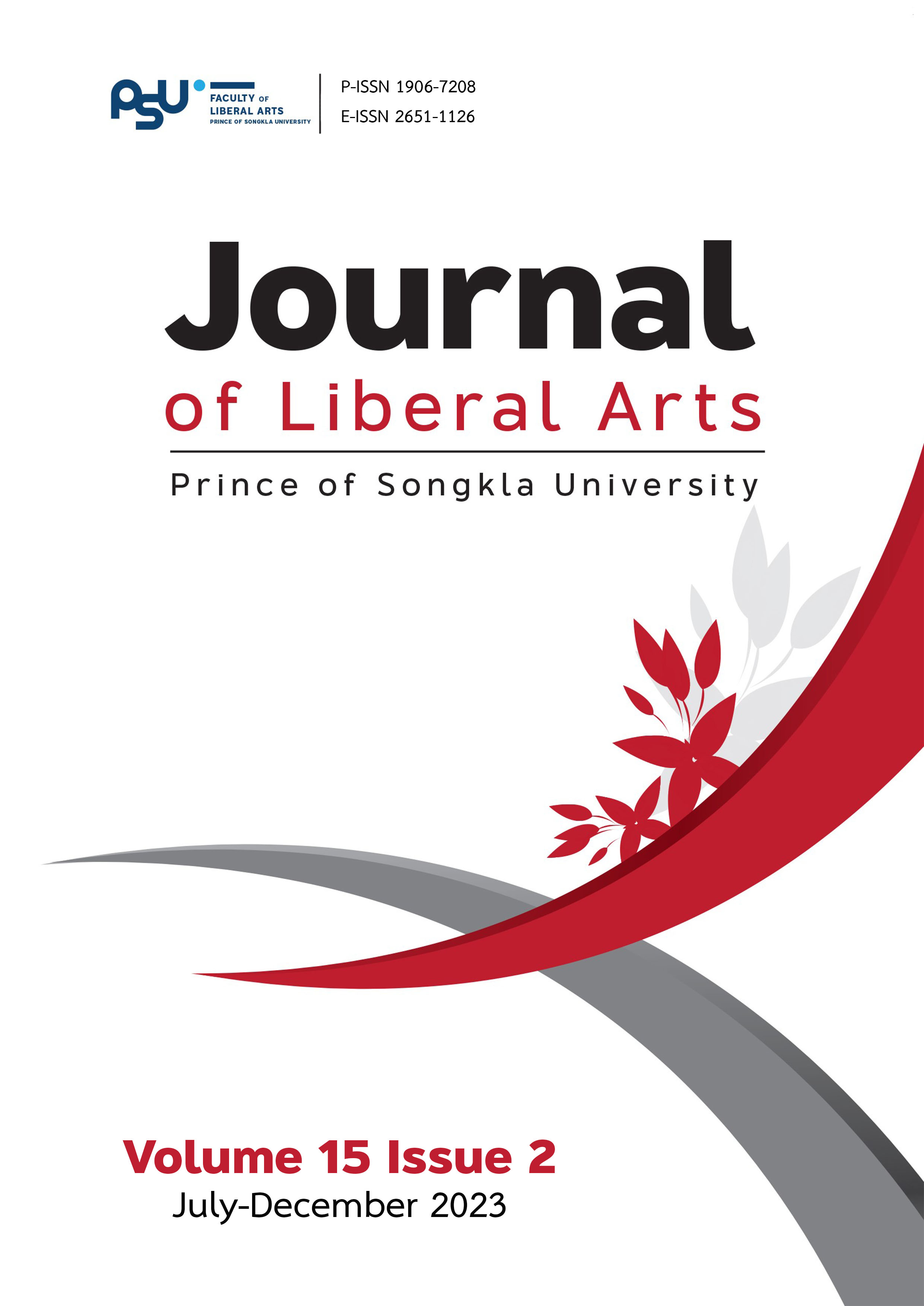Peter and Wendy and Narratological Point of View: A Stylistic Analysis
DOI:
https://doi.org/10.14456/jlapsu.2023.17Keywords:
narrative point of view, modality, children’s literature, cognitive stylistics, Peter and WendyAbstract
Acclaimed as a classic of children’s literature, James Barrie’s Peter and Wendy (1911) displays a theme of eternal youth through the protagonist's heartless characteristics. Although the story has intrigued a worldwide audience due to fantastical elements and memorable characters, the narrative complexity of the story has been mostly critiqued based on psychological and positivistic literary criticism, but stylistic perspectives have not been stressed. This study focuses on the relationship between the narrative structure and the narrator’s reliability, controversially articulated by literary scholars and readers. The objectives are to analyze the stylistic point of view employed through its composite narrative and to discuss how the results contribute to the narrator’s psycho-pathography and ideology transmission. This study applies Simpson’s (1993) narrative point of view and Leech and Short’s (2007) speech and thought presentation to investigate the ontological distance of the obscure narrator. The results show that the narrative point of view is sporadically ambivalent, based on the shifting shading of modalities. Although the narrative slippage leads to sceptic reliability, ideology transmission remains unaffected because the narrator’s authoritativeness is copiously enacted. Employing the stylistic framework to demonstrate the sophisticated point of view offers bona fide facets to literary criticism where linguistic evidence is of significance for interpretive discussion.
References
Abbott, H. P. (2002). The Cambridge introduction to narrative. Cambridge.
Al-Alami, S. (2016). The power of short stories, novellas and novels in today’s world. International Journal of Language and Literature, 4(1), 21-35.
Asper, K. (1993). The abandoned child within: On losing and regaining self-worth. Fromm International Publishing.
Bal, M., & Van Boheemen, C. (2009). Narratology: Introduction to the theory of narrative. University of Toronto Press.
Barrie, J. M. (1896). Margaret Ogilvy. Hodder and Stoughton.
Barrie, J. M. (1911). Peter and Wendy. Hodder and Stoughton.
Bray J (2010) Writing presentation, the epistolary novel and free indirect thought. In McIntyre, B. Buss & M. Short (Eds.). Language and Style: in Honour of Mick Short (pp.388-401). Palgrave Macmillan.
Brown, T. (2013). Breaking the fourth wall. Edinburgh University Press.
Dunbar, J. (1970). JM Barrie; The man behind the image. Houghton Mifflin.
Fludernik, M. (1993). Second person fiction: Narrative" you" as addressee and/or protagonist. AAA: Arbeiten aus Anglistik und Amerikanistik, 217-247.
Fowler, R. (1996). Linguistic criticism. Oxford University Press.
Frey, C. H., & Griffith, J. W. (1987). The literary heritage of childhood: An appraisal of children's classics in the Western tradition. Greenwood.
Genette, G. (1988). Narrative discourse revisited. Cornell University Press.
Genette, G. (1980). Narrative discourse. Cornell University Press.
Giovanelli, M., & Mason, J. (2018). The language of literature. Cambridge University Press.
Green, R. L. (1969). Tellers of tales: Children's books and their authors from 1880 to 1968. Kaye & Ward.
Hansen, P. (2007). Reconsidering the unreliable narrator. Semiotica, 165, 227-246.
Hollindale, P. (2005). A hundred years of Peter Pan. Children's Literature in Education, 36(3), 197-215.
Jeffries, L., & McIntyre, D. (2010). Stylistics. Cambridge University Press.
Katheryn, R. C. (2018). I, you, or he: Examining the impact of point of view on narrative persuasion, Media Psychology, 21(4), 700-718. https://doi.org/10.1080/15213269.2017.1400443
Leech, G. N., & Short, M. (2007). Style in fiction: A linguistic introduction to English fictional prose. Pearson Education.
McIntyre, D. (2004). Point of view in drama: A socio-pragmatic analysis of Dennis Potter’s “Brimstone and Treacle”. Language and Literature, 13(2), 139-160.
Nodelman, P., & Reimer, M. (2003). The pleasures of children’s literature. Allyn and Bacon
Rimmon-Kenan, S. (2002) Narrative fiction: Contemporary. Routledge.
Rose, J. (1984). Peter Pan and literature for the child. In The case of Peter Pan or the impossibility of children’s fiction (pp. 66-86). Palgrave Macmillan.
Routh, C. (2021). Peter Pan: Flawed or fledgling “hero”?. In A Necessary Fantasy? (pp. 291-307). Routledge.
Schofield, D. (1998). The second person: A point of view? The function of the second-person pronoun in narrative prose fiction (Doctoral dissertation, Deakin University).
Schulz, P. (2018). Children as commodities: Conflicting discourses of protection and abuse of children. Children Australia, 43(4), 231-244.
Semino, E., & Short, M. (2004). Corpus stylistics: Speech, writing and thought presentation in a corpus of English writing. Routledge.
Simpson, P. (1993). Language, ideology and point of view. Routledge.
Simpson, P. (2010). Point of view. In D. McIntyre & B. Busse (eds.) Language and style. Palgrave Macmillan, 293-310.
Spink, J. (1989). Children as readers. Billing and Sons Ltd.
Stanzel, F. K. (1984). A theory of narrative. Cambridge University Press.
Thorne, B. (1987). Re-visioning women and social change: Where are the children? Gender & Society, 1(1), 85-109.
Toolan, M. J. (2013). Narrative: A critical linguistic introduction. Routledge.
Townsend, J. R. (1969). Didacticism in modern dress. Horn Book, 43, 159-64.
Van Leeuwen, T. (2008). Discourse and practice: New tools for critical discourse analysis. Oxford University Press.
Vathanalaoha, K. (2016). Power relations and disillusion of patriarchy in “Peter Pan and Wendy”. Journal of Humanities. Naresuan University, 13(1), 79-96
West, M. (1997). Trust your children: Voices against censorship in children's literature. Neal-Schuman.
Werth, P. (1999). Text worlds: Representing conceptual space in discourse. Prentice Hall
Yeoman, A. (1998) Now or Neverland: Peter Pan and the myth of eternal youth. University of Toronto Press.
Downloads
Published
How to Cite
Issue
Section
License
Copyright (c) 2023 Kriangkrai Vathanalaoha

This work is licensed under a Creative Commons Attribution-NonCommercial-NoDerivatives 4.0 International License.
The authors retain the copyright to their article but the Journal of Liberal Arts, Prince of Songkla University reserves the exclusive rights to first publication.






